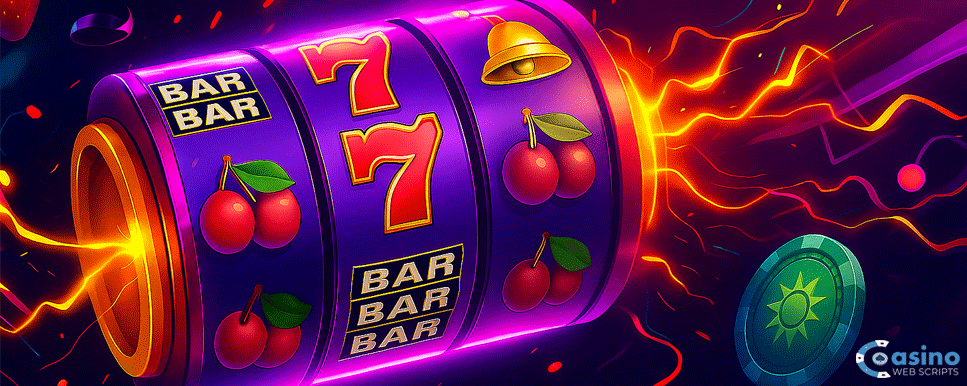When Slot Features Go Too Far: Balancing Fun and Addiction
In today’s iGaming landscape, slot design is an art form built on several elements: psychology, animation, and engagement strategy. The flashing lights, cascading reels, and endless bonus triggers all work together to keep players entertained - and ideally, coming back for more.
But in recent years, something curious has happened: the line between engaging gameplay and compulsive gameplay has blurred. Each new slot release seems to introduce more features, more feedback loops, and more ways to win - even when you’re actually losing, big time.
The question developers now face is no longer “How can we make players excited?” but rather, “At what point does excitement become excess?”
The Evolution of Slot Features
Slot machines started with simplicity: three reels, one payline, and a lever. Wins were clear, outcomes were binary, and gameplay was direct. The player either hit the right combination or didn’t.
As technology evolved, so did creativity. Multi-line slots, themed symbols, and free spin bonuses transformed the experience from mechanical to emotional. Developers learned that variety and unpredictability heightened excitement and engagement - the same principles that drive all good entertainment.
Then came the feature boom.
Cascading reels, wild multipliers, pick bonuses, megaways mechanics, hold-and-spin rounds, progressive jackpots - the list goes on. Each innovation brought something new to the table.
But it also created an arms race. Studios began to stack features upon features in a bid to stand out, often merging several mechanics in one game. The result? An experience so packed with stimulation that it’s hard for players to distinguish where the entertainment ends and the conditioning begins.
The Psychology of “Constant Winning”
Modern slot design is built around one of the most powerful behavioral principles known to psychology: variable reward schedules.
When rewards are unpredictable, the brain releases dopamine - the neurotransmitter linked to pleasure and anticipation. This is the same mechanism that drives social media engagement, lottery play, and even checking notifications.
Slots use this mechanism perfectly. You never know when the next big hit is coming, and that uncertainty is thrilling. But as games have evolved, developers have layered in even more subtle psychological hooks, including:
1. Losses Disguised as Wins (LDWs)
Even when a spin results in a net loss, the game might celebrate it with flashing animations and sound effects. The brain registers this as a win, so it reinforces play even though the balance is dropping.
2. The Illusion of Control
By letting players “choose” between bonuses, gamble their wins, or pick mystery symbols, games create a sense of agency - even though the outcomes remain random.
3. Micro-Rewards and Teasers
Near-wins, scatter teases, and partial bonuses all simulate progress. The feeling of “almost” hitting a bonus can be just as stimulating as actually winning it.
In one particular slot I tested recently, every spin felt like a minor celebration. Symbols burst into light, coins scattered, and sound effects rewarded even the smallest combinations. It was mesmerizing - a constant stream of feedback that made each spin feel successful.
And yet, by the end of the session, the balance told a different story.
The game had masterfully created an illusion of constant success. It’s smart design, no doubt - but it also made me stop and think about where we draw the line.
When Features Overload the Player
Adding features is an easy way to make a slot feel rich and exciting, but too many can actually harm the experience. Here’s why:
1. Cognitive Overload
When players are bombarded with animations, sound cues, and bonus triggers, they struggle to process what’s happening. Instead of feeling in control, they’re swept up in a blur of motion - and that can be both exhilarating and disorienting.
2. Perpetual Stimulation
In a game where something happens on every spin - a small win, a tease, a respin - the player never experiences downtime. There’s no pause, no reset moment. Over time, this non-stop stimulation mimics the psychological state of hyperfocus - where players lose track of time and money.
3. Blurred Feedback
When wins, losses, and teases all look and sound alike, clarity disappears. Players can’t intuitively tell how well they’re doing, and that can make players feel confused or unsure about what they’re actually winning.
How Much Is Enough? Finding the Right Balance
Determining the “right” number of features in a slot isn’t an exact science. It depends on theme, audience, and gameplay style. But there are some guiding principles that can help developers maintain balance between fun and excess.
1. The Purpose Check
Before adding a new mechanic, ask: What does this feature do for the player?
- Does it introduce new excitement?
- Or is it simply another reward loop to stretch session length?
Each feature should have a clear purpose and ethically enhance the emotional rhythm of the game.
2. The Transparency Check
Can players easily understand when they’re winning, losing, or just breaking even?
If the interface or animations blur those distinctions, it might be time to simplify. Transparency builds trust and long-term retention.
3. The Pacing Check
Great slot design mirrors storytelling - tension, buildup, release.
Players need both high-energy moments and calm periods. Continuous intensity leads to fatigue. Allowing natural pauses between bonus triggers or win animations gives the player time to breathe - and paradoxically, makes big moments feel bigger.
4. Player Autonomy
Interactive features should give players real choices. For example:
- Picking volatility modes (high vs. low risk).
- Choosing between feature paths that genuinely alter gameplay.
Decorative interactivity - buttons that appear to offer control but don’t - risks eroding trust.
5. Responsible Data Use
Data analytics are essential for modern slot development. But they can be used responsibly: track engagement to identify enjoyment, not just time spent.
If metrics show abnormally long sessions or low cash-out rates, that might indicate overstimulation - a sign the balance is off.
6. The “Less Is More” Philosophy
Some of the industry’s most successful titles have one or two strong features executed exceptionally well. A tight, clear concept often performs better than an overloaded one.
Creating Games People Return To - For the Right Reasons
In the short term, high-intensity games may generate impressive engagement metrics. Players are drawn to the spectacle, the near-constant wins, and the adrenaline rush.
But long-term player loyalty comes from trust. Games that feel fair, transparent, and enjoyable over time build stronger communities and repeat engagement.
From a business standpoint, it’s a sustainable model: responsible design reduces regulatory risk and reputational damage. It also positions studios as ethical innovators - an essential differentiator as regulators tighten scrutiny on “dark patterns” in game design.
The Ethics of Player Experience
There’s no denying that slot development is a business built on engagement. But ethical engagement isn’t a contradiction - it’s a competitive advantage.
Today’s players are more informed than ever. They understand randomness, volatility, and odds. What they value now is experience quality - a sense that the game respects their time and intelligence.
An ethical approach to slot design means:
- Clear feedback (so wins and losses are easily distinguished).
- Honest representation of odds.
- Reasonable pacing.
- Optional responsible gaming tools (session timers, win/loss summaries, play reminders).
Drawing the Line
Every developer must decide where to draw the line.
Do you prioritize maximum stimulation, or meaningful engagement? Do you want players to feel exhilarated - or entranced?
There’s no universal formula, but there is a guiding question worth asking during every stage of development:
“Are we rewarding the player’s attention - or taking advantage of it?”
If the answer leans toward the latter, it might be time to step back.
The Future of Responsible Slot Innovation
As the iGaming industry matures, the conversation around responsible design is shifting.
Studios are experimenting with ways to maintain excitement while promoting healthier play:
- Smart pacing systems that moderate bonus frequency.
- Transparency tools that clearly show win/loss trends.
- Adaptive features that adjust volatility based on playtime or bet patterns.
When engagement is built on clarity, rhythm, and emotional intelligence, everyone wins: the player, the studio, and the industry’s reputation as a whole.
Conclusion
Slot games have come a long way from mechanical fruit machines to digital worlds of sound, motion, and interactivity. Every innovation - from multipliers to megaways - was born from creativity and competition. But in chasing engagement, many designs have crossed into overstimulation.
We must ask ourselves:
- How do we entertain responsibly?
- How do we make players feel good without losing sight of reality?
Because at the end of the day, the best slot experiences have to make players want to come back for the right reasons.












